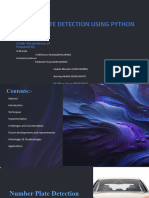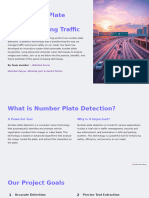Matlab Project: Number Plate Detection Using MATLAB
Matlab Project: Number Plate Detection Using MATLAB
Uploaded by
amadeus171203Copyright:
Available Formats
Matlab Project: Number Plate Detection Using MATLAB
Matlab Project: Number Plate Detection Using MATLAB
Uploaded by
amadeus171203Original Description:
Original Title
Copyright
Available Formats
Share this document
Did you find this document useful?
Is this content inappropriate?
Copyright:
Available Formats
Matlab Project: Number Plate Detection Using MATLAB
Matlab Project: Number Plate Detection Using MATLAB
Uploaded by
amadeus171203Copyright:
Available Formats
MATLAB PROJECT
Number Plate Detection using MATLAB
Explore the powerful capabilities of MATLAB in the realm of number plate detection. This presentation
will guide you through the essential steps and techniques involved in this cutting-edge computer vision
application.
Capturing and Preprocessing
the Image
The first step in number plate detection is to capture a high-quality
image of the vehicle. This is typically done using a digital camera or
security camera mounted on the street. The captured image must be
preprocessed to enhance the number plate region and prepare it for
further analysis.
Preprocessing steps may include resizing, color correction, and noise
reduction to improve the image quality and make the number plate more
visible and readable.
Edge Detection and
Segmentation
1. Edge detection is a crucial step in number plate detection, which
identifies the boundaries of the plate within the image.
2. Techniques like Canny edge detection or Sobel operators are
commonly used to highlight the edges of the license plate.
3. Segmentation then divides the image into distinct regions, isolating
the license plate area from the background and other objects.
Character Extraction
Binarization 1
Convert the image to black and white
to isolate the characters from the
background. 2 Connected Components
Identify the individual connected
components that represent the
Morphological Filtering 3 characters in the license plate.
Apply morphological operations to
clean up the character regions and
remove noise or unwanted elements.
Character Segmentation
After extracting the characters from the number
plate region, the next step is character
segmentation. This involves isolating each
individual character so they can be recognized
using optical character recognition (OCR).
The character segmentation process typically
involves techniques like vertical and horizontal
projection, connected component analysis, and
adaptive thresholding to accurately separate
each character.
Optical Character Recognition (OCR)
1 Character Extraction 2 Template Matching
The extracted characters from the number The OCR system compares the extracted
plate are input into an OCR algorithm, characters against a database of known
which uses machine learning models to number plate templates to verify the
recognize and classify each individual format and layout of the plate.
character.
3 Contextual Analysis 4 Confidence Scoring
The recognized characters are further The OCR system assigns a confidence
validated by considering the context, such score to the recognized characters,
as the expected pattern and location of allowing for the identification of uncertain
number plates in the region. or ambiguous results.
Validation and Verification
Accuracy Check Database Integration Security Measures
Verify the accuracy of the Integrate the system with a Implement robust security
extracted license plate number comprehensive vehicle protocols to protect the system
against a database of registered registration database to cross- from unauthorized access and
vehicles to ensure reliability. reference the detected plate ensure the confidentiality of the
and confirm its validity. vehicle data.
Challenges and Limitations
While number plate detection using MATLAB has proven effective, it
faces several challenges and limitations. Varying lighting conditions, low
image quality, and complex backgrounds can hinder accurate plate
identification. Additionally, dealing with overlapping plates, obscured
text, and non-standard plate formats presents ongoing difficulties.
Occlusion and plate deformation, such as tilting or distortion, can also
impact detection accuracy. Properly handling these issues requires
advanced image processing techniques and robust algorithms.
Applications of Number Plate Detection
Traffic Monitoring Toll Collection
Automatic number plate recognition (ANPR) Number plate detection enables electronic
systems help monitor traffic, enforce parking toll collection, reducing traffic congestion
regulations, and track vehicle movements for and improving the efficiency of toll roads and
improved urban planning and security. bridges.
Law Enforcement Vehicle Access Control
ANPR cameras can identify stolen vehicles, Number plate recognition grants or denies
suspect vehicles, and traffic violators, access to secure areas, garages, and private
assisting law enforcement in catching communities, enhancing security and
criminals and improving public safety. convenience.
Conclusion and Future Directions
Conclusion
1
Robust number plate detection is a crucial capability for various applications.
Challenges
2 Overcoming environmental factors and plate variations remains
an ongoing research area.
Future Directions
3 Leveraging deep learning and adaptive
algorithms to improve accuracy and reliability.
In conclusion, the number plate detection system presented in this work demonstrates the potential of
MATLAB for effective vehicle identification. However, ongoing research is necessary to address the
challenges posed by complex environments and evolving plate designs. Future directions include the
incorporation of deep learning techniques and adaptive algorithms to enhance the system's robustness
and adaptability, paving the way for more advanced transportation and security applications.
You might also like
- Automatic License Plate Recognition (ALPR) : A State-of-the-Art ReviewNo ratings yetAutomatic License Plate Recognition (ALPR) : A State-of-the-Art Review15 pages
- IBM Spectrum Protect 7.1.4 Implementation and Administration - LSGNo ratings yetIBM Spectrum Protect 7.1.4 Implementation and Administration - LSG24 pages
- Automated Vehicle License Plate Detection System Using Image Processing Algorithms PDFNo ratings yetAutomated Vehicle License Plate Detection System Using Image Processing Algorithms PDF5 pages
- A Review of Automatic License Plate Recognition System in Mobile-Based PlatformNo ratings yetA Review of Automatic License Plate Recognition System in Mobile-Based Platform6 pages
- Vehicle Number Plate Detection Using MatlabNo ratings yetVehicle Number Plate Detection Using Matlab12 pages
- LPRS (License Plate Recognition System)No ratings yetLPRS (License Plate Recognition System)19 pages
- (2013) An Algorithm For Accuracy Enhancement of License Plate RecognitionNo ratings yet(2013) An Algorithm For Accuracy Enhancement of License Plate Recognition11 pages
- Vehicle Number Plate Detection Under Different Environmental ConditionsNo ratings yetVehicle Number Plate Detection Under Different Environmental Conditions7 pages
- Comparative Analysis of Different Segmentation Techniques For Automatic Number Plate RecognitionNo ratings yetComparative Analysis of Different Segmentation Techniques For Automatic Number Plate Recognition4 pages
- Automatic Number Plate Recognition SystemNo ratings yetAutomatic Number Plate Recognition System10 pages
- Automatic_Traffic_Management_Report_ExpandedNo ratings yetAutomatic_Traffic_Management_Report_Expanded13 pages
- Automatic Vehicle Licence Plate Recognition Using CNN: ISSN:2395-1079No ratings yetAutomatic Vehicle Licence Plate Recognition Using CNN: ISSN:2395-10796 pages
- An Efficient Method For Number Plate Detection and Extraction Using White Pixel Detection (WPD) MethodNo ratings yetAn Efficient Method For Number Plate Detection and Extraction Using White Pixel Detection (WPD) Method7 pages
- Automated Vehicle Security System Using ALPR and Face DetectionNo ratings yetAutomated Vehicle Security System Using ALPR and Face Detection9 pages
- Recognition of Vehicle Number Plate Using MatlabNo ratings yetRecognition of Vehicle Number Plate Using Matlab8 pages
- R Eal T Ime L Icense P Late R Ecognition S YstemNo ratings yetR Eal T Ime L Icense P Late R Ecognition S Ystem5 pages
- An Efficient Automated Vehicle License Plate Recognition System Under Image ProcessingNo ratings yetAn Efficient Automated Vehicle License Plate Recognition System Under Image Processing8 pages
- Automatic License Plate Recognition Using OpticalNo ratings yetAutomatic License Plate Recognition Using Optical8 pages
- A Review Paper On License Plate Recognition SystemNo ratings yetA Review Paper On License Plate Recognition System3 pages
- Vehicle License Plate Identification System Using Aritifical Neural - Ppt1No ratings yetVehicle License Plate Identification System Using Aritifical Neural - Ppt115 pages
- Development of Automatic Vehicle Plate Detection System: Norizam@ump - Edu.myNo ratings yetDevelopment of Automatic Vehicle Plate Detection System: Norizam@ump - Edu.my6 pages
- Proposal For Automatic License and Number Plate Recognition System For Vehicle IdentificationNo ratings yetProposal For Automatic License and Number Plate Recognition System For Vehicle Identification5 pages
- Ijret - Number Plate Recognition Using Ocr TechniqueNo ratings yetIjret - Number Plate Recognition Using Ocr Technique5 pages
- A Method of Vehicle License Plate Detection For Traffic Violation Detection Based On Vertical Edge DetectionNo ratings yetA Method of Vehicle License Plate Detection For Traffic Violation Detection Based On Vertical Edge Detection6 pages
- AUTOMATIC_LICENSE_PLATE_RECOGNITION_USING_IMAGE_PRNo ratings yetAUTOMATIC_LICENSE_PLATE_RECOGNITION_USING_IMAGE_PR8 pages
- G J E S R: A Review On License Plate Recognition Based Anti Signal Detection SystemNo ratings yetG J E S R: A Review On License Plate Recognition Based Anti Signal Detection System7 pages
- Image Processing Based Toll Automation Using AnprNo ratings yetImage Processing Based Toll Automation Using Anpr4 pages
- Automatic License Plate Detection System For Myanmar Vehicle License Plates100% (2)Automatic License Plate Detection System For Myanmar Vehicle License Plates5 pages
- Automatic Number Plate Recognition: Unlocking the Potential of Computer Vision TechnologyFrom EverandAutomatic Number Plate Recognition: Unlocking the Potential of Computer Vision TechnologyNo ratings yet
- Application Protocol: Flows (/lua/flows - Stats - Lua) Hosts Devices InterfacesNo ratings yetApplication Protocol: Flows (/lua/flows - Stats - Lua) Hosts Devices Interfaces4 pages
- Building Auxiliary Systems - Security and Controls OutlineNo ratings yetBuilding Auxiliary Systems - Security and Controls Outline6 pages
- You Want To Transfer Existing '/ip Firewall Filter' Configuration From One Router To A NewNo ratings yetYou Want To Transfer Existing '/ip Firewall Filter' Configuration From One Router To A New6 pages
- Online Hotel Management System Synopsis ReportNo ratings yetOnline Hotel Management System Synopsis Report33 pages
- Installing and Configuring The TPM ModuleNo ratings yetInstalling and Configuring The TPM Module4 pages
- Ticket Reservation For From Chirala To Hyderabad On Service 119 Ticket No: TravelsNo ratings yetTicket Reservation For From Chirala To Hyderabad On Service 119 Ticket No: Travels2 pages
- Voucher-LANDAK WIFI-1GB-up-733-05.20.24-Voucher WiFi 1 GB Om Jius 20 Mei 2024No ratings yetVoucher-LANDAK WIFI-1GB-up-733-05.20.24-Voucher WiFi 1 GB Om Jius 20 Mei 20247 pages
- Automatic License Plate Recognition (ALPR) : A State-of-the-Art ReviewAutomatic License Plate Recognition (ALPR) : A State-of-the-Art Review
- IBM Spectrum Protect 7.1.4 Implementation and Administration - LSGIBM Spectrum Protect 7.1.4 Implementation and Administration - LSG
- Automated Vehicle License Plate Detection System Using Image Processing Algorithms PDFAutomated Vehicle License Plate Detection System Using Image Processing Algorithms PDF
- A Review of Automatic License Plate Recognition System in Mobile-Based PlatformA Review of Automatic License Plate Recognition System in Mobile-Based Platform
- (2013) An Algorithm For Accuracy Enhancement of License Plate Recognition(2013) An Algorithm For Accuracy Enhancement of License Plate Recognition
- Vehicle Number Plate Detection Under Different Environmental ConditionsVehicle Number Plate Detection Under Different Environmental Conditions
- Comparative Analysis of Different Segmentation Techniques For Automatic Number Plate RecognitionComparative Analysis of Different Segmentation Techniques For Automatic Number Plate Recognition
- Automatic Vehicle Licence Plate Recognition Using CNN: ISSN:2395-1079Automatic Vehicle Licence Plate Recognition Using CNN: ISSN:2395-1079
- An Efficient Method For Number Plate Detection and Extraction Using White Pixel Detection (WPD) MethodAn Efficient Method For Number Plate Detection and Extraction Using White Pixel Detection (WPD) Method
- Automated Vehicle Security System Using ALPR and Face DetectionAutomated Vehicle Security System Using ALPR and Face Detection
- An Efficient Automated Vehicle License Plate Recognition System Under Image ProcessingAn Efficient Automated Vehicle License Plate Recognition System Under Image Processing
- A Review Paper On License Plate Recognition SystemA Review Paper On License Plate Recognition System
- Vehicle License Plate Identification System Using Aritifical Neural - Ppt1Vehicle License Plate Identification System Using Aritifical Neural - Ppt1
- Development of Automatic Vehicle Plate Detection System: Norizam@ump - Edu.myDevelopment of Automatic Vehicle Plate Detection System: Norizam@ump - Edu.my
- Proposal For Automatic License and Number Plate Recognition System For Vehicle IdentificationProposal For Automatic License and Number Plate Recognition System For Vehicle Identification
- Ijret - Number Plate Recognition Using Ocr TechniqueIjret - Number Plate Recognition Using Ocr Technique
- A Method of Vehicle License Plate Detection For Traffic Violation Detection Based On Vertical Edge DetectionA Method of Vehicle License Plate Detection For Traffic Violation Detection Based On Vertical Edge Detection
- AUTOMATIC_LICENSE_PLATE_RECOGNITION_USING_IMAGE_PRAUTOMATIC_LICENSE_PLATE_RECOGNITION_USING_IMAGE_PR
- G J E S R: A Review On License Plate Recognition Based Anti Signal Detection SystemG J E S R: A Review On License Plate Recognition Based Anti Signal Detection System
- Automatic License Plate Detection System For Myanmar Vehicle License PlatesAutomatic License Plate Detection System For Myanmar Vehicle License Plates
- Automatic Number Plate Recognition: Unlocking the Potential of Computer Vision TechnologyFrom EverandAutomatic Number Plate Recognition: Unlocking the Potential of Computer Vision Technology
- Application Protocol: Flows (/lua/flows - Stats - Lua) Hosts Devices InterfacesApplication Protocol: Flows (/lua/flows - Stats - Lua) Hosts Devices Interfaces
- Building Auxiliary Systems - Security and Controls OutlineBuilding Auxiliary Systems - Security and Controls Outline
- You Want To Transfer Existing '/ip Firewall Filter' Configuration From One Router To A NewYou Want To Transfer Existing '/ip Firewall Filter' Configuration From One Router To A New
- Ticket Reservation For From Chirala To Hyderabad On Service 119 Ticket No: TravelsTicket Reservation For From Chirala To Hyderabad On Service 119 Ticket No: Travels
- Voucher-LANDAK WIFI-1GB-up-733-05.20.24-Voucher WiFi 1 GB Om Jius 20 Mei 2024Voucher-LANDAK WIFI-1GB-up-733-05.20.24-Voucher WiFi 1 GB Om Jius 20 Mei 2024

























































































